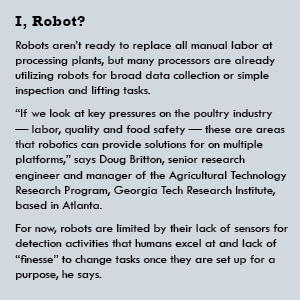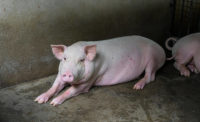
|
At Cargill, plants have implemented camera-augmented beef grading and brand certification with the United States Department of Agriculture (USDA).
“This is considered to be a ‘best practice’ and streamlines operations by reducing the number of re-graded carcasses, as well as reducing down time,” says Michael Martin, director of communications, Cargill Inc., based in Minneapolis. The processor also conducts tenderness audits for its beef.
To increase its sustainability, Cargill is capturing methane gas generated from its water treatment ponds, which is then used as a fuel source for boilers that heat water for sanitation at the beef processing facilities, he says.
“This technology allows us to offset approximately 25 percent to 30 percent of our energy use at these facilities,” says Martin. “We also re-use water up to three times before treating and discharging it, with treatment between each use.”
At Cargill’s two pork-processing facilities (Beardstown, Ill., and Ottumwa, Iowa) as well, captured methane gas is used as a fuel source that offsets about 15 percent of those plants’ energy requirements.
“Process controls imply measurement, which is essential for ongoing improvement,” notes Martin. “We cannot properly manage or improve processes unless we can measure their performance.”
Improving older systems
Kayem Foods proves it is possible to combine innovative process controls with, in some cases, 70-year-old smokehouses.
“Some products still come out better in the older cooking system, so we look at what technologies improve efficiencies and throughput and maintain quality,” says Robert Campbell, Ph.D., quality assurance food safety manager, Kayem Foods, based in Chelsea, Mass. “Our new cooking system — cooking in a package so there is no post-cooking contamination — offers more control of data acquisition and temperature controls, and improves yields and energy efficiency by having more precise process controls.”
Kayem Foods has also invested in new filtration systems to decrease its total water usage by recycling its water, Campbell says.
To improve worker safety, he says Kayem Foods is working on a number of systems such as automatic lookouts and electric eye systems so machines stop if someone enters a potentially unsafe zone.
“With new process-control systems, the biggest issue is getting our mechanics up to date and investing in their training,” says Campbell, “because you can’t plunk a system down and it works right away.”
Cutting implementation costs
According to Lee Johnson, Ph.D., vice president of technical services, West Liberty Foods, based in West Liberty, Iowa, robotics and automation in processing operations are the next big devices for improving process control.
“We look at automation as a tool in the process: either as a standalone feature like a boot wash or equipment that can replace an employee or as part of a much larger process such as creating a new way to slice product that is better,” says Johnson.
New technology enables West Liberty Foods, for example, to slice 10-foot logs of product, he notes.
Although data-capture systems have been around for 15 to 20 years, Johnson points out that implementation of new technology is much more economical.
“As industry challenges, such as regulatory and food-safety issues, become tougher every day, if automation can make some things simpler then that’s a good thing,” he says.





Report Abusive Comment